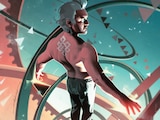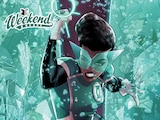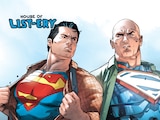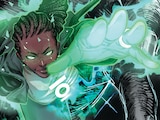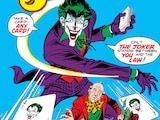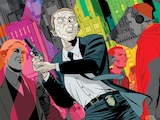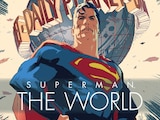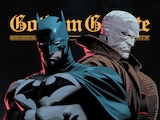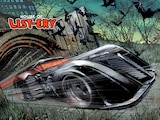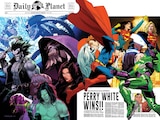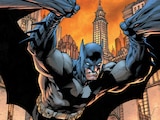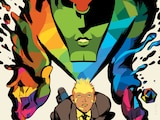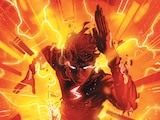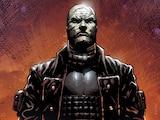Now streaming on Hulu and HBO Max, Suicide Squad ISEKAI represents what may be the most intense collaboration between DC and a Japanese studio to date as the first DC anime series. But this latest chapter is by no means the first. There’s been a long history of collaboration between the American-born art form of DC’s superhero comics and the unique manga and anime culture of Japan. Comics, after all, are a worldwide phenomenon. With ISEKAI now reaching its climactic final episodes, the timing seemed right for a look at some of these earlier projects, in case you find yourself hungry for more DC anime and manga after it ends.

The Jiro Kuwata Bat-Manga (1966)
In the 1960s, Adam West and Burt Ward rappelled up the side of the world surfing the wave of “Batmania.” Thanks to a hit Batman television show, the eyes of the world were on a Gotham City presented in glorious color. And Japan was no exception. Capitalizing on Batman’s popularity, Japanese manga publisher Shōnen Gahōsha secured the rights from DC to put out their own Japanese Batman comic during the height of the Batman craze, enlisting manga creator Jiro Kuwata to translate Batman for a Japanese audience.
For decades, these comics were completely unknown to Western audiences, until they were discovered by DC graphic designer Chip Kidd and republished in English for the first time in part by 2008, and in full in 2014. It remains one of the most fascinating chapters of Batman history to this day.

Batman: The Third Mask (1996)
In 1996, DC was crafting their first anthology project inviting the most prestigious names in the industry to tell their own short Batman stories—stripped of color and taking the character to his most fundamental basics. They called it Batman: Black and White. Casting their net beyond the Western talent pool, one of the most brilliant feathers in the collection’s cap was a short story in the fourth issue by Katsuhiro Otomo, legendary creator of the seminal, generation-defining masterpiece Akira. Astoundingly, in the midst of just a few brief pages detailing Batman’s pursuit of a killer, Otomo arrives at the core truth of Batman it sometimes takes years for the most dedicated fans to realize: neither Batman nor Bruce Wayne is the character’s true self, but a third facet kept private to the world.

Batman: Child of Dreams (2000)
Before the rediscovery of the Bat-Manga, Batman: Child of Dreams had the distinction of being the first licensed DC manga published in English, produced with manga publisher Kodansha. Child of Dreams, created by Kia Asamiya and adapted to English by Max Allan Collins, appropriately contains a story of Batman pursuing a case to Tokyo. A pioneering work in American and Japanese comics collaboration, the series was not without its hiccups—for instance, because manga reads from right to left, every page was flipped for American audiences in the English translation. This meant that, for example, Two-Face’s scars would appear on the wrong side of his face.

CMX (2004-2010)
After Child of Dreams, DC experimented with adapting more original manga for English audiences under its own imprint, CMX. Over six years, CMX localized over fifty manga titles, including classics of the medium such as Crayon Shin-chan, Gon, Emma, Kikaider, MADARA, Phantom Thief Jeanne and From Eroica With Love.

Batman: Gotham Knight (2008)
DC’s first anime studio collaboration was one of their most ambitious partnerships to date, an often-overlooked chapter in Christopher Nolan’s Dark Knight saga set between Batman Begins and The Dark Knight. This anthology film comprised of six different shorts, produced by four different anime studios, helped to grow the legend of the Dark Knight.
Studio 4°C (Spriggan, Tekkonkinkreet) would animate “Have I Got a Story For You” and “Working Through Pain,” and go on to collaborate with DC on such feature films as Green Lantern: Emerald Knights and Justice League: The Flashpoint Paradox. Production I.G (Ghost in the Shell, Psycho-Pass) would give us the Greg Rucka-written short “Crossfire.” Bee Train (Noir, .hack//Sign) animated the Lucius Fox and Bruce Wayne-heavy “Field Test,” and Madhouse (Trigun, Death Note, One Punch Man) gave us the Batman vs. Killer Croc battle “In Darkness Dwells” and the collection’s train-straddling highlight, “Deadshot.” Through all of it, the Dark Knight is voiced by the irreplaceable Kevin Conroy. An absolute gem of DC’s animated film collection to this day.

Batman: Death Mask (2008)
A new Nolan-inspired wave of Batmania reaching its peak brought with it another original manga, this time by Togari creator Yoshinori Natsume. Here, Batman returns to Japan to revisit his early training and resolve lingering mysteries connected to this overlooked chapter of his youth. This time, perhaps due to their CMX experience, DC had the foresight to keep the pages going right to left.

DC Super Heroes vs. Eagle Talon (2017)
Don’t worry, no need to turn in your fan card if you’ve never heard of this one—DC Super Heroes vs. Eagle Talon was never released in the west. This Japan-exclusive anime film was a crossover tie-in to the Japanese action-comedy series Eagle Talon, which follows the titular criminal organization with designs on world domination. Eagle Talon’s greatest threat through the film isn’t the Justice League itself, though. It’s balancing the film’s budget until the end for them to afford the expensive licensing fees of the Justice League appearing in their movie.

Batman Ninja (2018)
Batman Ninja has the distinction of being one of DC’s first CGI animated films as well as its first non-anthological anime project released worldwide. In collaboration with Kamikaze Douga, YamatoWorks and Barnum Studio, Batman Ninja takes Batman, Nightwing, Red Hood, Red Robin, Damian Wayne and Catwoman back in time to a feudal Japan terrorized by the escaped inmates of Arkham Asylum. Nonstop epic showdowns with Joker and Harley Quinn, Poison Ivy, Deathstroke, Two-Face, Penguin, Bane and Gorilla Grodd make this one of the most exciting, action-packed films in the DC library and a cult classic six years later.
Perhaps most surprising (and delightful) of all, a sequel was announced just this summer—Batman Ninja vs. Yakuza League. We’ll be here to cover it as it comes.

Batman and the Justice League (2018)
Only the first three volumes of this four-volume saga by Shiori Teshirogi have been published to date in English. But even incomplete, Batman and the Justice League gives us perhaps the most comprehensive look at the DC Universe through a manga creator’s eyes, as the world’s most notorious villains vie for control of the mystical powers of the world’s ley lines—from the Joker, to Ocean Master, to Sinestro and beyond.

Joker: One Operation Joker/Superman vs. Meshi/Batman: Justice Buster (2023)
This decade, DC has been stepping up its involvement in Japanese comics and animation like never before. For the past few years, some of the most exciting and inventive DC stories have been published through a manga collaboration with Kodansha. How inventive? One Operation Joker is the story of Batman’s greatest villain forced to care for a Batman who’s reverted to a baby after a chemical accident. In Superman vs. Meshi, the Man of Tomorrow develops an obsession with Japanese casual dining. Meanwhile, Batman: Justice Buster, arguably the most straightforward of the bunch, reinvents the Batman mythology as a modern seinen manga series.
If those sound outlandish to you, give them a shot and expand your view on the kinds of stories that are possible with these characters. Manga and anime have been breaking boundaries on what the DC Universe can do since 1966 and their cross-cultural collaboration will continue to expand the limits of DC storytelling as we view our heroes and history through new perspectives. Ikuzo!
Suicide Squad ISEKAI is now streaming on Max.
Alex Jaffe is the author of our monthly "Ask the Question" column and writes about TV, movies, comics and superhero history for DC.com. Follow him on Bluesky at @AlexJaffe and find him in the DC Official Discord server as HubCityQuestion.
NOTE: The views and opinions expressed in this feature are solely those of Alex Jaffe and do not necessarily reflect those of DC or Warner Bros. Discovery, nor should they be read as confirmation or denial of future DC plans.

